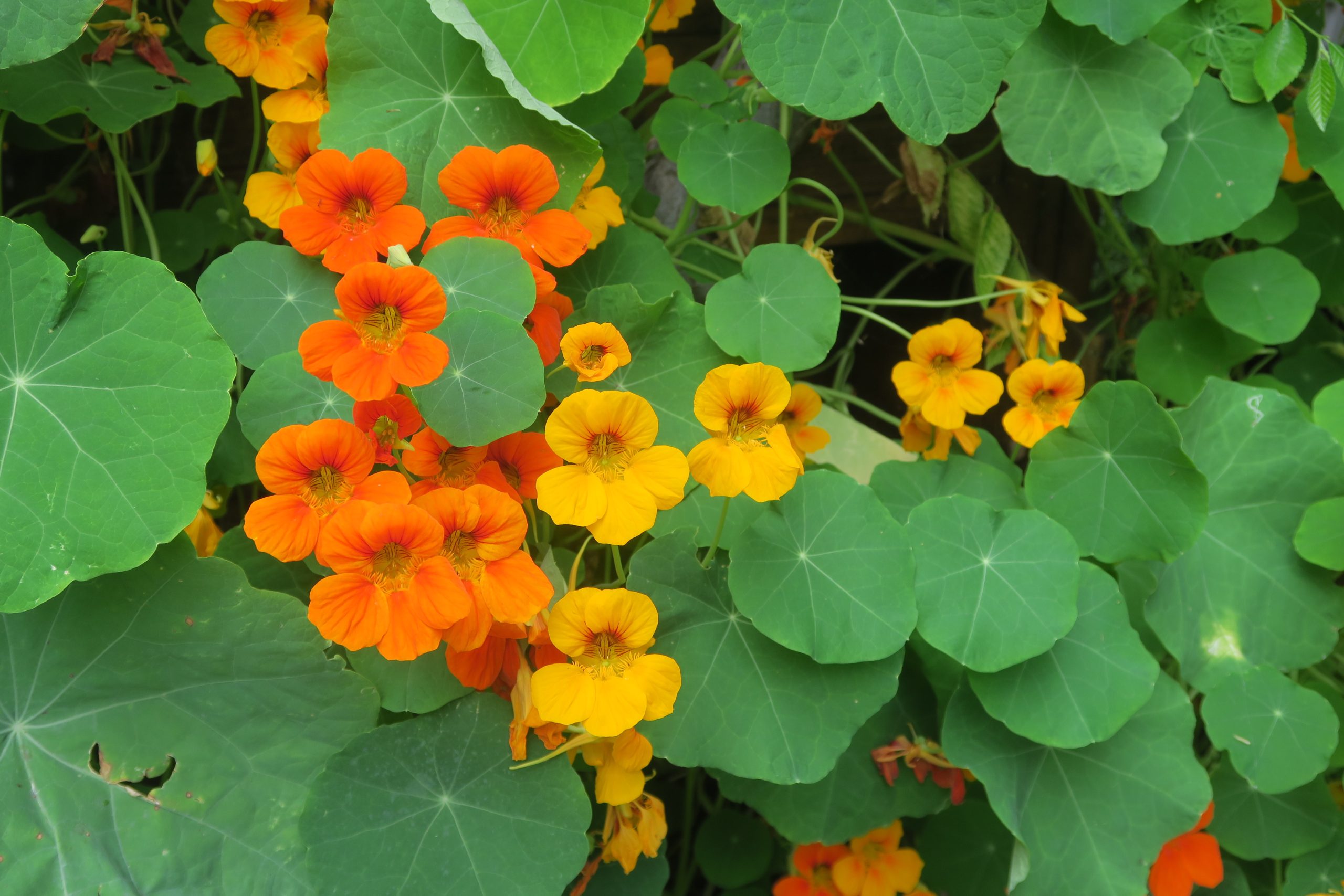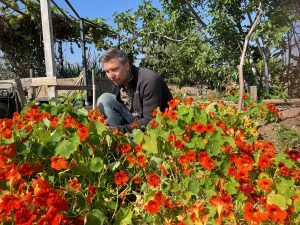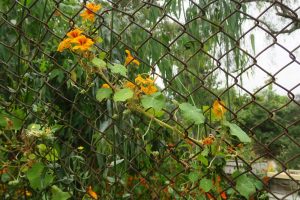GETTING TO KNOW THE NASTURTIUM PLANT
(Tropaeolum majus and related species.)
A tasty food that’s easy to grow in your backyard
By Christopher Nyerges
[Nyerges is the author of “Foraging California,” “Foraging Edible Wild Plants of North America,” and other books. He teaches regular classes about the uses of wild plants. His schedule is found at www.SchoolofSelf-Reliance.com.]
Right now, at this time of the year, you might notice brilliant red, orange, and yellow flowers all from the same plant, in the flower gardens of your neighbors. You might be seeing the flowers of the nasturtium plant, with its distinctive round leaves.
I was still in my late teens when a friend of my mother introduced me to the colorful nasturtium plant that was growing in her yard. She handed me a leaf and I began chewing on its long, succulent stem. There was an initial sweetness. I liked it. But as I chewed, the sweetness gave way to a hot pepperiness—like a hot radish or horseradish—which quickly increased in intensity. The ultimate effect was similar to the aftereffects of horseradish or eating too much wasabi — open sinuses and watery eyes.
“Wow,” I said, blinking away the tears, “that’s good!”
I had never noticed the nasturtium plant before that day, but then, as I observed the yards of neighbors, I realized it was very common. This Peruvian native has now spread all along the west coast of north and south America, and has widely spread throughout the world in ornamental and edible gardens. It was introduced into Europe way back in 1686 because going back to the very beginning, the plant was widely regarded for its beauty.
The plant grows as a sprawling vine, often growing as a border plant, but also growing over fences and walls.
The round tender stalks seldom grow thicker than ¼ inch in diameter, but it can sprawl out six feet from the root, or more, putting out round leaves and colorful flowers all along the way. The unique leaves are round-shaped, about 2 to 5 inches in diameter, with a long succulent leaf stem is attached to the underside of the leaf.
But most people are raising nasturtiums for the flowers. The red, yellow, or orange flowers are shaped somewhat like a horn—with the spur at one end, opening into a bell shape at the other. The five colorful petals are distinct (not united to each other at all); three of the petals have side projections, or guide hairs, at the base, which guide insects to the nectar. To reach this nectar, insects are brought into contact with the stamens and pistil, which is nasturtium’s way of achieving pollination. I have watch bees, mason bees, and hummingbirds all dance around the nasturtium flowers in search of the nectar in the flower.
And the plant is easy to grow, since it actually prefers poor soil, in which it usually produces an abundance of flowers. In richer soils, it tends to produce more leaves.
Later in the season when the flowers mature, the seeds are produced. These two-globed seeds bear an uncanny resemblance to the human brain.
Nasturtium is an annual, but in most cases where this is grown, the seeds just drop to the ground and resprout the following season, year after year. In other words, it’s a self-sustaining garden plant that can also be eaten.
WAYS TO PREPARE NASTURTIUM
Although every part of the plant above ground can be eaten raw or cooked, the leaves are most commonly eaten. The leaves can simply be picked and eaten raw; they can be added to any type of salad—potato, cucumber, lettuce, and so forth. They can be chopped finely and added to soups, omelettes, and potato dishes; they can be cooked and eaten like spinach. One novel way to prepare a nasturtium leaf is to use it stuffed grape-leaf-type recipes (i.e., dolmas).
The stems (preferably the long succulent ones) are a bit hotter and juicier than the leaves. They are best eaten raw, such as in salads, but chopped fine.
The flowers are very popular in all salads, since it adds a flair of color in addition to the mildly hot and mildly sweet flavor.
Another unique food from the nasturtium is to pickle the young green seedpods, and then use them like capers.
Here’s one of my favorite nasturtium recipes:
NASTURTIUM CREAM CHEESE SPREAD
1 bunch small radishes
1 tablespoon finely chopped nasturtium leaves
1 teaspoon lemon juice
8 ounces cream cheese
Coarsely grate the washed radishes, leaving a few thinly sliced for garnish. Quickly blend the grated radishes, nasturtium leaves, lemon juice, and cream cheese. Spread immediately onto thinly sliced rye or pumpernickel bread, or onto rye crackers. Serve it soon after making because the nasturtium leaves tend to become slightly bitter if allowed to stand after being with other ingredients.
According to WebMD: “People take nasturtium in combination with other herbs for infections of the kidney, bladder, or urethra (urinary tract infections or UTIs), infections of the airways, and many other conditions, but there is no good scientific evidence to support these uses. How does it work? Nasturtium contains vitamin C and might help fight bacteria, fungi, viruses, and tumors.”




